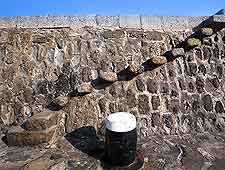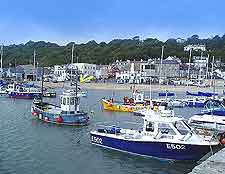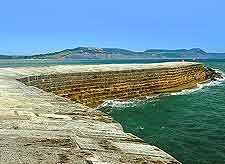Lyme Regis History Facts and Timeline
(Lyme Regis, Dorset, England)

The modest size of Lyme Regis belies the important role that it has played in history. Today, it is known as the 'Pearl of Dorset'.
Lyme Regis takes its name from its location on the mouth of the River Lym - Lym simply means 'torrent of water'.
Early Origins
During the Roman occupation, the town was known as Lym Supra Mare. However, the first written evidence of a settlement at Lyme dates back to 774 AD. It tells of the gifting of land by Cynewulf, King of Wessex, to the Abbot of Sherborne, in order to set up a salt works.

A Royal Town
In 1284, Lyme was granted a Royal Charter by King Edward I, after which the title of 'Regis' could be added to the town's name.
Lyme Regis also had the right to form a Guild and sent two Members to Parliament. The Cobb - a curving harbour wall - dates from the 13th century and was built to protect shipping during stormy weather. It certainly helped in the development of Lyme as a thriving port. There's also evidence that in 1340, King Edward III granted a licence to build a new watermill.
The 17th century was a particularly tumultuous period in Lyme's history and it witnessed a great deal of action during the English Civil War. In 1644, the town had to withstand a lengthy siege by Royalist forces. The town succeeded in defeating them, although there were many casualties. Then, in 1685, the Duke of Monmouth chose to land at Lyme Regis when he embarked on the ill-fated Monmouth Rebellion to oust the king.
A Place of Discovery
By the mid-18th century, Lyme Regis had become a popular seaside resort. Many writers and painters visited, including Henry Fielding, Turner and Whistler. Jane Austin penned 'Persuasion' during her time in the town between 1803 and 1804.
One of Lyme's most famous residents is Mary Anning. Born in Lyme Regis in 1799, she was only 12 years old when she became the first person to excavate an Ichthyosaur fossil from the cliffs. Mary went on to become an important researcher in the field of fossils and paleontology. Fossil collecting in Lyme Regis wasn't without its dangers - in 1839, a huge landslide occurred at Downlands, to the west of the town. Today, this area is known as the Undercliff.

Modern Lyme
In 1903, the railway finally made its way to Lyme Regis. With it came the birth of tourism in the town. Some 60 years later, the town lost its railway station during a national scheme of cut-backs, making Axminster the nearest railway station today.
In 1980, a touch of Hollywood arrived in Lyme Regis when 'The French Lieutenant's Woman', starring Meryl Streep and Jeremy Irons, was filmed here. Today, Lyme Regis continues to attract fossil hunters, who can head out with experts to search for their own piece of history.
 The modest size of Lyme Regis belies the important role that it has played in history. Today, it is known as the 'Pearl of Dorset'.
The modest size of Lyme Regis belies the important role that it has played in history. Today, it is known as the 'Pearl of Dorset'.
